Courtesy of Northeastern Speedway Website|
We shouldn't really worry about track conditions in the old days because the cars were built so well and such safety in mind. A woman was in this one !
BILL'S
[Somewhat] WEEKLY COLUMN/BLOG PAGE
BILL’S BACK IN TIME
By Bill Ladabouche
FLYING OFF IN THOSE DAYS OF YORE
Although we still don't have this problem totally sorted out, I can safely say that race drivers flying off the race track in the old days certainly faced a less certain future than they do today. Especially in the formative early 1950's, a stock car oval could be scratched out almost anywhere that some promising promoter could lay his hands on some acreage. Today, our fewer tracks and stronger concentration on driver safety have smoothed this out a bit.
Courtesy of
Northeastern Speedway Website|
We shouldn't
really worry about track conditions in the old days because the cars were built
so well and such safety in mind. A woman was in this one !
What
got me onto this particular kick was actually a track that is still in operation
today – Fonda Speedway, at the Montgomery County Fairgrounds in Fonda, NY. For
all intents and purposes, the speedway was established in 1953, previous auto
racing there being somewhat spotty. When Jim Gage and Ed Feuz founded The Track
of Champions, they inherited a devilishly – tricky, asymmetrical old horse track
with no one corner being the same as another. But, that was not what has made
the problem at Fonda to which I refer.
What makes Fonda somewhat unique is its very close proximity to the New York State Canal on the Mohawk River. An aerial view shows the river is just mere yards from the back stretch, and a number of cars have either gone in the water or have dangled on the muddy banks. Fortunately, it doesn't appear to be a very deep area of the canal/river right there. Nonetheless, a few Fonda regulars, over he years, have expressed the sentiment of being anxious about the prospect of taking a dunk.
Historic Aerials.Com
The
irregular Fonda track lies close to the Mohawk [that black area at bottom].
Below – The Dave Buanno car coming up out of the drink. And this was his prized,
new innovative tubular chassis car.
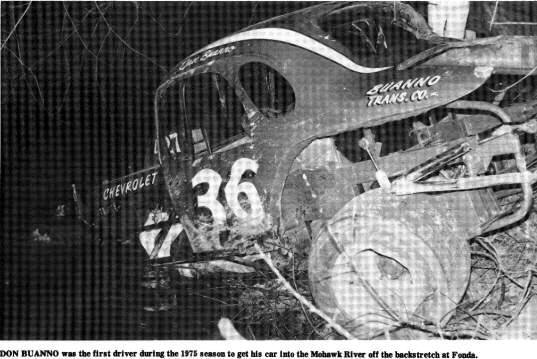
Ladabouche Collection
The best – known photo shows a late 1970's – style modified lying on its side, inches from the water. I also have a shot of one of Dave Buanno's coupes [perhaps his famous tubular chassis car] being hauled out of the Mohawk. Poor Dave – Fonda hasn't been very kind to him, all in all, given the recent serious injury he received there as a supposedly uninvolved spectator.
Buanno, from the Fort Johnson trucking family, is best known for two things there – showing huge improvement when he bought what was, at the time, a state – of – the art tubular chassis [might have been a Schwinning – not sure] and for being the brother – in – law to Cyclone Forrette. That's another story entirely.
Actually, there aren't many great places to fly off the track at Fonda. I don't know if anyone ever went through the fences and ended out on Route 30A or not [although I know there were serious spectator injuries when people used to watch the races, on stepladders, out on the 30A shoulder. Few tracks were built with driver safety at the forefront, and Fonda certainly isn't one of them. None of the three fatalities at the track were caused by drivers flying off the track, however.
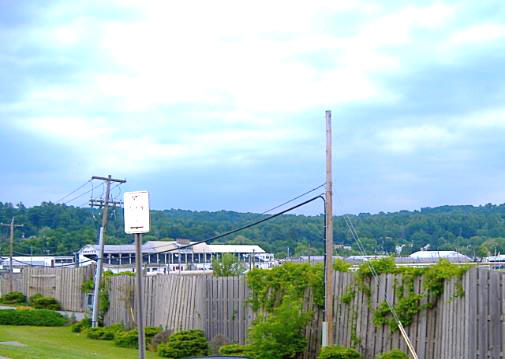
Midstate Club Site
Photo
These aging barriers b y Rte 30A
attest to Fonda's efforts to keep anyone from hanging out at the fences
during the racing action. Below – Bouvrette Speedway car in the ditch in the
infield.
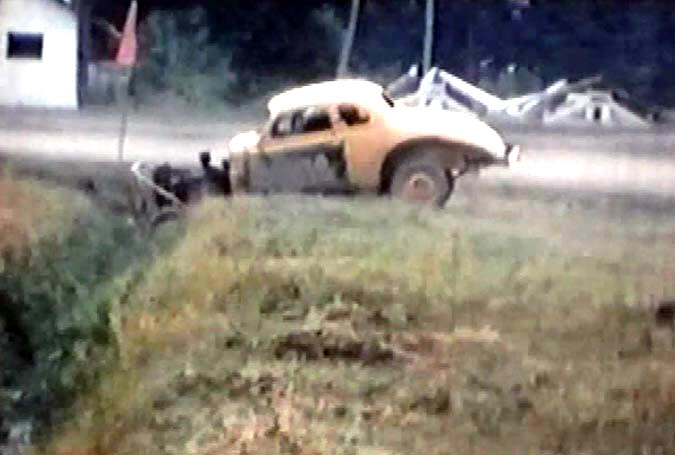
Courtesy of the
LaBreche Family
Another old track that could be a poster child for
off – track driver danger was the now – gone Bouvrette Speedway, another old
horse racing facility in St. Jerome, Quebec. An unbelievable program to behold,
promoter Gustave Bouvrette would start each race with a jeep pickup rigged
similarly to the F-150's they use at the Saratoga trotter track now. Bouvrette
attracted huge fields of those old jalopies and was the starting point for
drivers such as Andre Manny, Jean Guy Chartrand, Jean-Paul Cabana, and Rejean
Field. It was a frequent spot for US drivers like Jackie Peterson, Bill Wimble,
the Trombleys, Buck Holliday, and Dick Goodelle to get in some extra racing.
Courtesy of the
LaBreche Family
Bouvrette was a reasonably nice
venue, with covered stands. Below – A well dressed group of dignitaries look
annoyed at
the camera. Whadda yew lookin at ? Or.. A qu'est-que ce vous regardez?
Bonnes Hommes [Canadian Good Fellas]
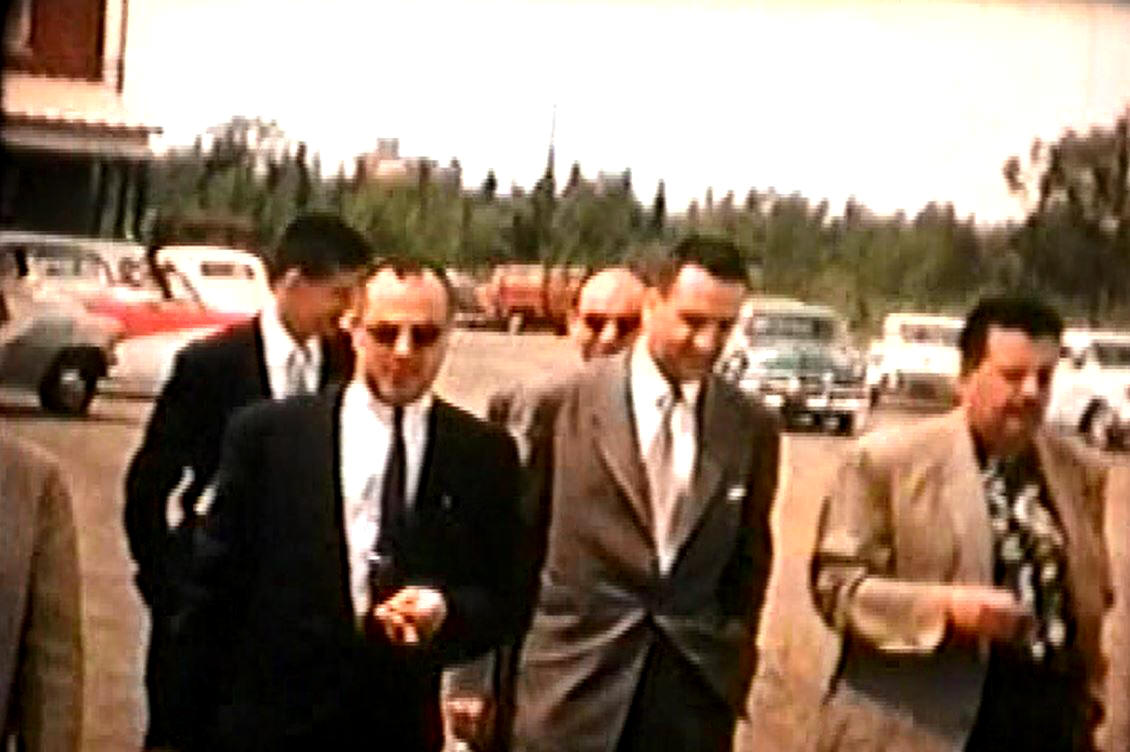
Courtesy of the
LaBreche Family
Bouvrette was a reasonably nice venue, with huge
covered stands and a nice, wide track. But, it wasn't a good place to fly off
from. Where there were not ditches, there were stable buildings, pasture barbed
wire fences, or sloping banks filled with assorted junk discarded from years of
pari – mutual betting races and [perhaps] county fair activity. I have been
lucky enough to view old 8MM footage lasting almost an hour, and it shows a
variety of disasters, most of which happened when one of those old hobby racers
left the racing surface.
I don't know what it was about those old days, when people loved to pose proudly around a car which someone had wrecked the bejeezus out of, but they did that on both sides of the border. One particular thirty second Bouvrette portion shows a coupe, nose down on a sloping hill, surrounded by dozens of large old wheels [wooden and metal alike]. The crewmen are holding these wheels up for the camera and clearing out tons of that junk so the wrecker could try to pull the car back up to the backstretch. I think the car ended up running again later that day; and, it could have had some great new racing wheels if they so desired. The fact that this crap presented a danger to at least bend up someone's cars – if not worse – was apparently not a concern to the participants.

Courtesy of the
LaBreche Family
Crews working to extricate a car
stare at the pile of old wooden wheels and other junk right off the racing
surface at
Bouvrette Speedway. Below – This guy got through the barbed wire into the
pasture.
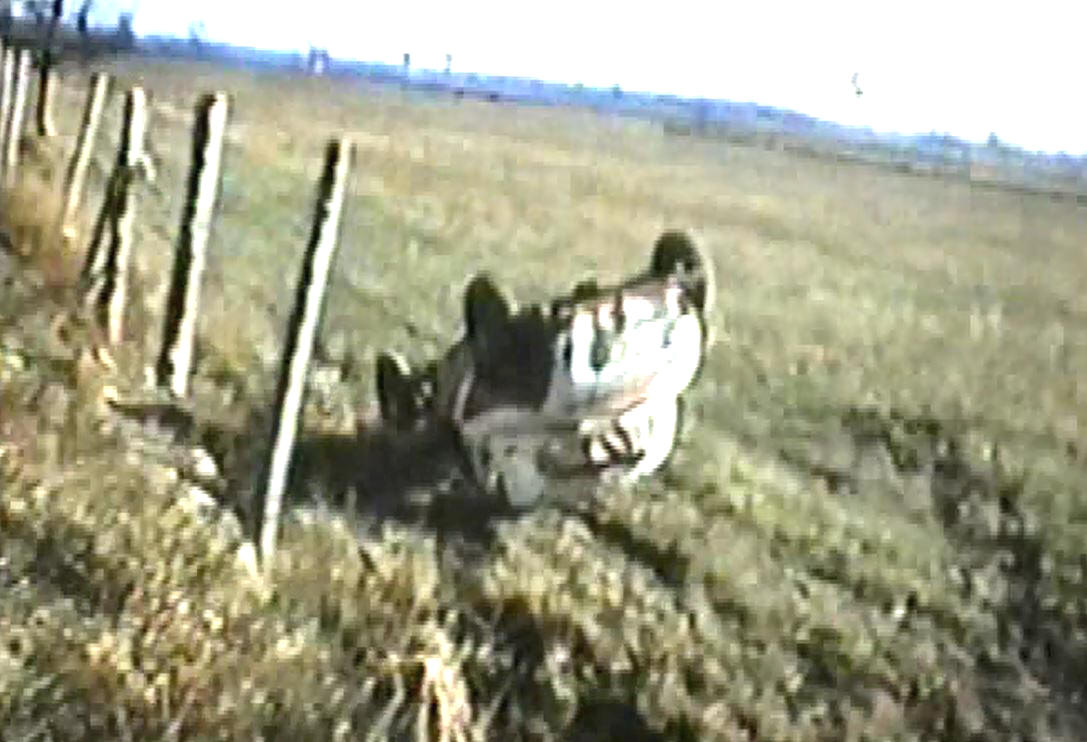
Courtesy of the LaBreche Family
Other shots of errant cars shows them upside down in a pasture, having somehow gotten past [or through] barbed wire fencing. Bouvrette was either profoundly dusty or it was so muddied up that – in either situation – the poor racers were driving by Braille. What is even more amazing is that this old footage shows dozens of folks attending this dust bowl in their best Sunday clothes. Other shots [including a terribly blurry one of Holliday] show cars that ended up in one of the drainage ditches that lined most of the track.
While the
pits were not in the infield, that area was populated by the usual flaggers and
photographers. Whoever was manning the old video camera has one fleeting portion
of his handiwork whereupon Chartrand, having locked up with another car, stays
on the gas and ends up coming directly at the camera man. Probably, it didn't
phase either one of them. Bouvrette has had cars end up everywhere except in the
stands. Footage shows, more than once, men standing on the track when the wildly
careening, poorly – handling stock cars were right there with them. There's no
accounting for those guys up there.
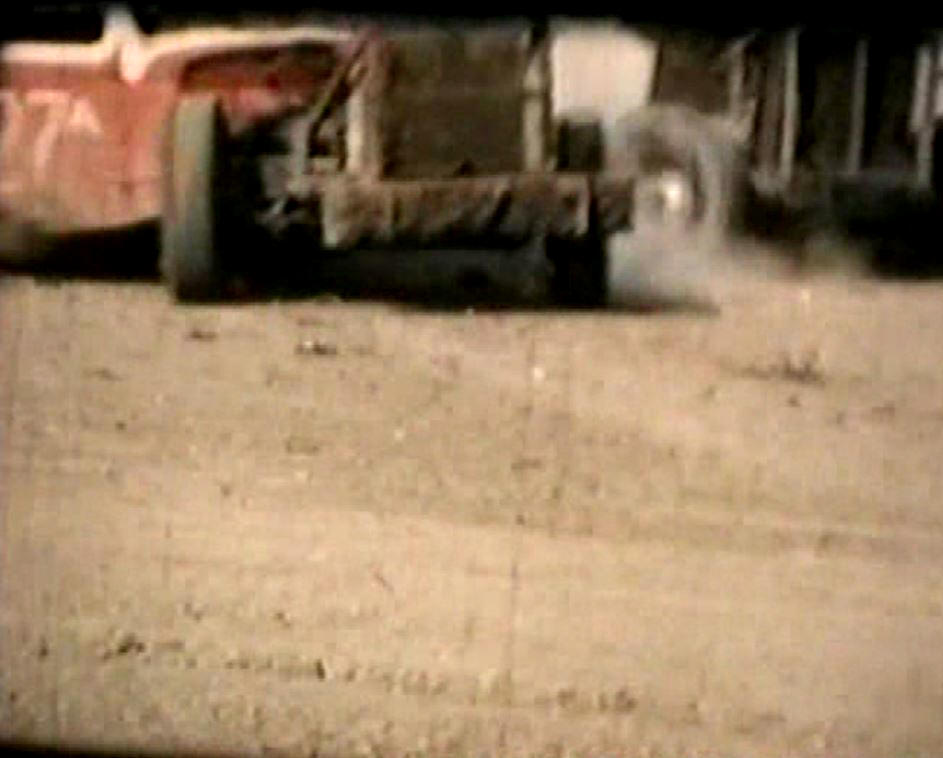
Courtesy of the
LaBreche Family
Future Canadian Hall of Fame driver
Andre Manny, still on the gas, heads right into the infield towards our camera
person.
Below- One of the lovely Bouvrette features were these wooden posts to protect
the damned advertising sign.
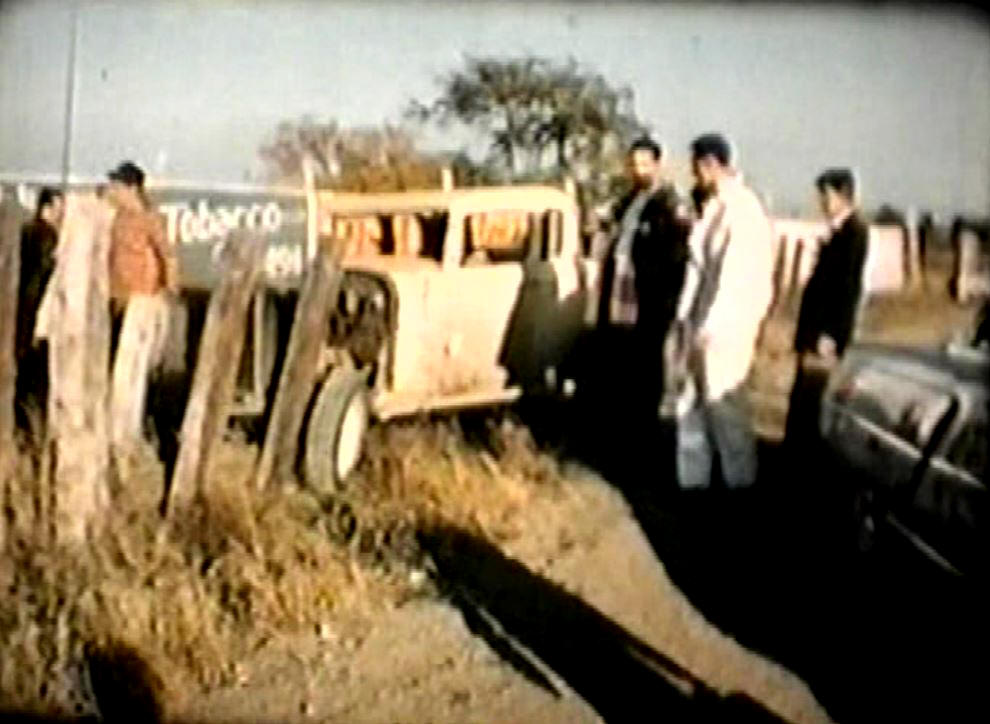
Courtesy of the LaBreche Family
Many early tracks were simply carved out of the woods somewhere. The best local example of this was the brief Ge-Jo-Clin track near Wells River, VT, in Boltonville. The venue, now the site of the Blue Mountain Union High School shows cars racing past piles of brush and dense copses of trees. There was obviously some clear areas there, as there had to be areas to watch the races and to have a pit area. With announcer and judges operating off what looked like a giant deer hunting stand and fans sitting on a flatbed truck, Ge-Jo-Clin might have been the most rustic track I have yet seen. I am sure a few errant jalopies did some impromptu logging.
The old Fairmont Park Motor Speedway, located on the old fairgrounds in Fair Haven, VT just yards from the New York state line, was another place with heavy woods bordering about a third of the track. Old shots from those days shows at least two cars that would up in the woods, shearing off trees. Fairmont's first promoter, Hugh Young, gave up the racing when a local named Marty Vinci was killed by a stray wheel when he was watching the races from a tree.
Courtesy of Northeastern Speedway Website
A driver at Je-Jo-Clin Speedway sits patiently while crews try to extract his
car from trackside puckerbrush. Below – Earl Maille, whose bad ride at
Ashland Park ended a good career.
From the Ed Feuz Collection
The race track in Warrensburgh, NY, alternately called Warrensburgh Speedway or Ashland Park was another such lovely place to swerve off from. Also an old fairgrounds, it had the typical old covered grandstands until 1960, and an assortment of places on the track from which you didn't want to eject: an old paddock building, one steep escarpement, and various terrible old fences. The most notable unfortunate accident there was that of burly Glens Falls driver Earl Maille, who had driven for a number of owners including Henry Caputo. Maille, reportedly driving a car 14 he had recently acquired, flew off the steep part into some rocks and broke his back. He never raced again.
In Vermont, one of the first tracks [along with Fairmont] to stage stock car races was at Dog River Speedway, supposedly another old fairgrounds track. Paper clip – shaped, the old half mile had a large percentage of its expanse bordering onto a steep hill that ran down to a set of frequently – used railroad tracks. Jackie recalls doing something similar to that, one afternoon at Northfield, only he was not alone.
Courtesy of Ed Fabian
Car 14, maybe the same one Earl Maille wrecked at Warrensburgh, sits in the trees off the old Fairmont Speedway track. Below – Action has stopped at the old Dog River Speedway in Northfield.
Courtesy of Northeastern Speedway Website
The great Roy “Pappy” Forsyth had flown off the turn with him, and the George Barber #46 car was doing some of the slowest, most nonchalant rolls Jackie had ever seen. The car landed gently on the tracks, below Jackie’s car which had been stopped on the hillside – perhaps by a tree. He laughs when he relates how quickly Forsyth managed to vacate the car, not waiting to see if a train was coming.
Down south in Rutland, the Vermont State Fair attempted to run races on a number of occasions. Today,the track remains, but it is largely unused as a racing oval. The various racing programs there experienced several unfortunate accidents from around 1958 through 1963. Located right in the city of Rutland, the track was simply unsuited for car racing. The track retaining fences were just wooden fencing. The third and fourth turns almost ran onto US Route 7, turn one had a concession stand with propane tanks right beside it, and the rest of the track dropped off, onto parking and midway space.
Courtesy of Norm Vadnais
Crews clean up the Vic Love wreck. He is sitting, scant feet from Roxie's propane tanks [see the Fried Clams sign]. Notice the fencing right there is sturdier since the Rabideau wreck a year before. Below – Art Rivers rolls over some of the ridiculous fencing. It's a wonder he wasn't hurt by splinters.
Courtesy of Wes Moody
1963 was the worst. First, the United Stock Car Racing Club of Harvey Tattersall staged a Grand American division race there during fair week. Tattersall's GA's were a motley copy of the NASCAR Grand Nationals, consisting of one or two op line late models, and the rest of the field ranged from older late models [all the way back to 1950] and even the occcasional rental car or two if necessary. The old fair water truck was inadequate, and the sun that day was unrelenting.
During the course of the race, Roy Halquist, who had the only brand new Ford, was leading the race by a huge margin with Dick Dixon second, Bob Devine third, and Mal Delameter fourth in a 1962 Chevy. Bad visibility caused Devine to lose control of his 1961 #24 Chevy and plunge through the wooden fencing on the backstretch. He landed on top of parked cars, pinning a woman's leg against a trailer hitch. She lost her leg, and Bob once told me he lost some of his urge to race anymore. In 2011, he still recalled the event vividly.
Vintage Modifieds Site
Dick Dixon finished second in the USCRC Grand American event with this
car. Below – Bob Devine, in happier days, with an earlier GA Chevy.
Courtesy of Tony Mordino, Jr.
Later that fall, C.J. Richards staged the last of his stock car races at the fairground. In the process of the race, Ed Baker of Warrensburgh, NY lost a wheel off his Hudson coupe. The wheel went through the fence, onto the sidewalk on North Main Street, and inflicted fatal injuries to a man who may have paused to watch the races through a fence. It is a wonder that a wheel never went off into the midway at the busy fair.
Another time, the Lebanon Valley Speedway management group staged a race at the fair in Rutland. Opinions vary on whether the race was choreographed due to those dangerous track conditions or not. At any rate, a couple of New Hampshire's lightweight flathhead cars decided to join the program, to the dismay of the Valley regulars who thought the lightwieght NH cars would have an advantage. During one of the events that afternoon, Brattleboro, Vermont's Sonny Rabideau [one of the NH cutdown invaders] found himself wedged under the first turn fence, literally a foot away from the propane tanks of Roxie's French Fries.
Ladabouche Photo
Vern Baker's low buck Hudson, the 6 PAC. Driver Ed Baker told me he figures it threw a wheel because his owner skipped on maintenance. Below - Some of a crowd of around 10,000 spills out onto the track as Sonny Rabideau and his unwelcome NH style cutdown win a Fair race a year after he was stuffed under the fence.
Courtesy of C.J. Richards
Ironically, a year later, in a CVRA race won by Rabideau over his fellow Fairmont Speedway competitors, Vic Love of Fair Haven found himself wedged in almost that same spot, staring out onto the midway at the Club 18 girlie show as cars slowed down , barely missing him. All this was enough for the fair committee finally, and racing there was never again scheduled. They did have a “display” once, with a few old stock cars. Guys like Butch Jelley, who had run in many of those ill – fated shows years before, ran around the track as fast as they dared, being watched by nervous fair officials. But that was the last of it.
In more modern times, Newport, Vermont's Can-Am Speedway could be a little hairy; however, the track was so bad that few cars could get going fast enough to fly off anything. Built on a portion of Charlie Nadeau's landfill, turn one was the place you didn't want to go off. It was a sharp drop down and God only knows what you might have ended up in at the bottom. Nadeau used a huge loader and chain to move stalled or wreck cars; I am not sure what he would have done had anyone gone all the way down.
Ladabouche Photo
You didn't want to fly off turn one at Can Am Speedway. There was stuff !
Below – Desperate people call for help after Ray Stygles impacted the tree at Thunder Road.
Courtesy of Cho LeeThunder Road International Speedbowl in Barre, Vermont – that 1960 creation of Ken Squier and the Cooley brothers, is one of the region's only healthy tracks today. Back when it was first built and we didn't know what we do now, Squier and the Cooleys had left a number of features from the site including some trees that were obviously too close to the track. Drivers were so concerned with avoiding hitting the railroad ties that were there before the eventual “widowmaker” front straightaway wall, that they often flew off turn three.
One particular day, conditions were just right for one of the tracks better drivers, Ray Stygles, to fly off with the George Hay #68 coupe. Stygles could not slow down as he was partially airborne and struck a tree there that was removed not long afterward. Stygles, from the same racing family as Arnie, Ralph, and any others who now race at Bear Ridge Speedway, was seriously injured in the crash and had no more racing career. That crash, along with one involving Wayne Vincent on the widowmaker, are arguably the two most recalled crashes in the 54 year -old history of the track. Today, the place you don't want to off is turn two. This will involved careening down a very steep embankment – more scary than dangerous.
Courtesy of Cho Lee
Thunder Road personnel, including a fully – uniformed nurse, respond to a wreck on the widowmaker around 1961. Below - At Staten Island's Weissglass Stadium, an errant car could go out onto a neighboring car dealership's lot, in full view of the nearby tenament houses.
Charles Zullo PhotoAll of this tracks, and dozens more with which I am not as familiar, are testimony to just how dangerous racing was in those early days. It is a miracle that there were not more fatalities than there actually were. Fonda, which had two fatalities in one year, has only had three, even considering its degree of difficulty; the ultra speedy Lebanon Valley has had fatalities, as have man others. Compared to the old sprint car racing, it is still a relatively small number of fatalities, but no less tragic. Today's safer barriers, water barriers, and the like are welcome additions to a sport where improvements are still needed. And that Mohawk River is still just off the backstretch at grand old Fonda.

Off the HAMB Chat Site
From both the aptly - named Riverside Park Speedway and at Weissglass, errant cars in the pits could roll into a river.
Please email me if you have any photos to lend me or information and corrections I could benefit from. Please do not submit anything you are not willing to allow me to use on my website - and thanks. Email is: wladabou@comcast.net . For those who still don’t like computers - my regular address is: Bill Ladabouche, 23 York Street, Swanton, Vermont 05488.
AS ALWAYS, DON’T FORGET TO CHECK OUT MY WEBSITE
www.catamountstadium.com
Return to the Main Page
Return to the Main News Page
Return to the All Links Page
Return to the Weekly Blog Links Page